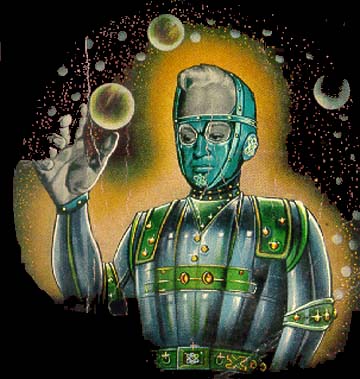

[MARS IN THE SHADOWS]
THE FRENCH ON MARS:
A HUNDRED YEARS RETROSPECTIVE
(1865-1965)
by Jacques GARIN


[MARS
IN THE SHADOWS]
THE FRENCH ON MARS:
A HUNDRED YEARS RETROSPECTIVE
(1865-1965)
by Jacques GARIN
Not all accounts reported below may have actually occurred. Each reader is invited to make up his or her own mind
about what may be "real", what may have been "fictionalized", or even entirely made up. For
an overall and subjective view of Earth's early space exploration and alien encountets (not limited to French sources),
please read Jean-Marc Lofficier's article,
From Cyrano to Jean-Luc Picard.
Titles of major Wold Newton importance have been highlighted in bright
yellow.
1865
François-Henri Peudefer de Parville - "Un Habitant de la Planète Mars" (An Inhabitant of Planet Mars)
(Hetzel).
The calcified body of a Martian, taken away from the red planet by a comet a long time ago, is dug up and recovered
in America. The body of the Martian appears to be roughly identical to that of a Man, and scientists conclude that
life on Mars is similar to that of Earth.
1884
Camille Flammarion - "Les Terres du Ciel" (The
Worlds in the Sky) (Marpon-Flammarion).
A man and woman who died at the top of a mountain find themselves reincarnated on Mars.
Includes a description of Martian fauna and flora.
1887
Guy de Maupassant - "L'Homme de Mars" (The
Man from Mars)
Short story likely inspired by Flammarion's works.

1888
Camille Flammarion - "La Planète Mars" [Planet
Mars] in "Rêves Étoilés" [Starry Dreams]
(Marpon-Flammarion).
A detailed description of Mars, with hints that Martians tried to communicate with Earth during its prehistory.
1889
Camille Flammarion - "Uranie" (Marpon-Flammarion).
A man awakens on Mars and meets his reincarnation.
 1889
1889
Henry de Graffigny & Georges Le Faure - "Les Aventures Extraordinaires
d'un Savant Russe" [The Amazing Adventures of a Russian Scientist] - Volume
2: "Le Soleil et les Petites Planètes" [The Sun and the Small
Planets] (Edinger).
A team of French and Russian scientists explore the Solar System on the Ossipoff. The heroes arrive on Phobos, which is atmospherically connected to Mars, and travel in a
balloon down to the Red Planet, wearing pressure suits. During the next five chapters, they meet winged humanoids,
masters of an aerial technological civilization.
1893
A. Vilgensofer - "La Terre dans 100.000 Ans" [Earth
in 100,000 Years] - Volume 1: "L'Ile
Enchantée" [The Enchanted
Island] (H. Simonis-Empis).
Prof. Anima wakes up 100,000 years in the future. Martians look like humans and have the same, advanced technology.
The two planets communicate via projectors.
Camille Flammarion - "La Fin du Monde" [The
End of the World] in La Science Illustrée Nos. 182-189.
In Part I, the Director of the Paris Observatory receives a "photophonic" message from Mars warning Mankind
about a giant comet.
1897
Tristan Bernard - "Qu'est-ce qu'ils peuvent bien nous dire?" [What can They Be Saying?] in "Contes
de Pantruche et d'Ailleurs".
Short, satirical story -- Earthmen believe the Martians are trying to communicate with them (via giant signs on
the ground) when, in fact, they're communicating with the Venusians.
1897
C. Paulon - "Un
Message de la Planète Mars" [A
Message from Planet Mars] in La Science
Illustrée Nos. 523-526.
Prof. Cozen attempts to communicate with
Mars, but is thwarted by weather conditions.
1899
Maurice Montégut - "Autre Planéte" [Another
Planet] in Le Journal, 5 Oct.
Astronomer Gallas Merrickh communicates
with a Martian via telepathy.
1901
Wilfrid de Fonvielle - "A la Surface de Mars" [On
the Surface of Mars] in Le Journal des
Voyages No. 220 (17 Feb), cover by Robida.
Description of a technologically advanced Martian civilization.
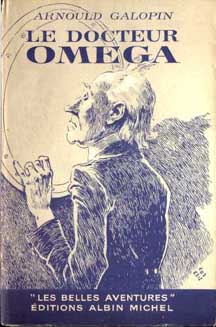 1905
1905
Michel Corday - "Les Signaux de Mars" [Signals
from Mars] in L'Auto
(1st July).
Satirical story: translated signals from Mars are about a card game in progress.
Arnould Galopin - "Le Docteur Oméga
- Aventures Fantastiques de Trois Français dans la Planète Mars"
[Dr. Omega - Fantastic Adventures Of Three
Frenchmen On Planet Mars] (Libr. Mondiale).
Dr. Omega
invents a spacecraft dubbed "Cosmos" to travel to the Red Planet. The "Cosmos" is a projectile-shaped
vehicle built using an antigravitational substance called "repulsite". It can also function on land and
under water. Mars turns out to be inhabited by extremely ugly aliens, dawrf-like beings with long, tentacled arms.
In a revised version, Les Chercheurs d'Inconnu
[Seekers of the Unknown] serialized in
12 issues in 1908-09, Galopin changed the name of the ship to "Excelsior" and the substance to "stellite".
1906
J.-H. Aubry - "Les
Marsiens" [The Marsians] in Jeunesse No.
11.
An astronomer describes Marsians as two-meter high vegetarians, with webbed hands, who live up to 200 years in
huge steel cities. Mars is mostly under water -- the Marsians travel by air or by sub-marine according to seasons.
Charles Torquet - "L'Appel d'un Autre Monde" [The
Call From Another World] in Je Sais Tout (15 Nov).
An American occultist who has visited Mars through astral travel reports the existence of two species of Martians:
hairy giants, four times the size of men, and smaller, wall-crawling troglodytes.
 1908
1908
Henri Gayar - "Les Aventures Merveilleuses
de Serge Myrandhal sur la Planète Mars" [The Wondrous Adventures Of Serge Myrandhal On The Planet
Mars] (Laumonier).
Myrandhal reaches Mars via a psychic-powered
ship named "Velox". The planet is inhabited by the Houas, small, red-furred anthropoids who live underground, and by the Zoas, beautiful winged humanoids, also referred to as "Elohim".
In a later version, published in 1927 as Les Robinsons de la Planète
Mars [The Robinsons of Planet Mars] under the pseudonym of "Cyrius", Gayar got rid of the psychic energy and instead
used the planetary force of attraction; he also added German villains to the plot and prophetically rechristened
the rocketships V1 and V2.
 Gustave Le Rouge - "Le Prisonnier de la Planète Mars"
[The Prisoner of Planet Mars] (Méricant).
Gustave Le Rouge - "Le Prisonnier de la Planète Mars"
[The Prisoner of Planet Mars] (Méricant).
American scientist Robert Darvel teams
up with a Hindu prince to use psychic mind power to propel a ship to Mars. Mars is elaborately described, with
its fauna and flora, including giant crabs and jelly-like octopi with pseudo-human faces. Darvel runs afoul of
the Erloors, Mars' hostile, bat-winged,
blood-sucking natives, a once-powerful civilization now ruled by the Great
Brain, a giant brain-like entity. The Great Brain gets rid of Darvel by sending
him back to Earth, unfortunately with some of the vampires in tow.
1909
Gustave Le Rouge - "La Guerre des Vampires" [War
of the Vampires] (Méricant).
Sequel to "Le Prisonnier de la Planète Mars".
This deals with the war on Earth against the Erloors, who want Darvel to return to Mars to destroy the Great Brain.
In spite of his fiancée being held hostage by the Vampires, Darvel wins the day.
 1911
1911
Jean de La Hire - "Le Mystére
des XV" [The
Mystery Of The XV] in Le Matin, 1911; reprinted as 2 vols., Le Secret des XII [The
Secret Of The XII] and Les Conquérants
de Mars [The Conquerors Of Mars] (Jaeger, 1954).
Mad scientist Oxus and his 14 associates
travel to Mars on a radioplane using a series of hertzian relays, planning to colonize the planet. There, he faces
his arch-enemy the Nyctalope,
and the Martians from H.-G. Wells' War of the Worlds.
The Nyctalope will use a ship propelled
by Cavorite to travel to planet Rhea in Le Roi de la Nuit
[The King Of The Night] (Le Matin, 1923).
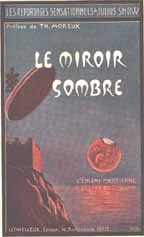
Abbot Théophile Moreux - "Le Miroir Sombre" [The
Dark Mirror] (Lethielleux); reprinted as Mars
va nous Parler [Mars Will Talk To Us] in the Journal des Voyages,
1924.
Earth scientists communicate with Mars through a radio-telescope-like device, the eponymous "dark mirror".
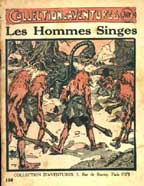 1912
1912
Marcel Laurian - "L'Étrange
Aventure de M. Narcisse Barbidon" [The Strange Adventure of Mr. Narcisse Barbidon] in Le Cri-Cri Nos.
47-73; reprinted as Les Hommes-Singes
[The Ape-Men] and La
Guerre des Nains et des Géants [The
War of the Dwarves and the Giants] (1919).
Like Verne's Hector Servadac, Prof. Barbidon, his daughter, nephew and man-servant are
carried to Mars on a chunk of Peru, after a meteorite crashed into the Earth. There, they encounter the technologically-advanced
and telepathic dwarves of the wondrous city of Lankmirakar. They help them in their battle against the luminous electro-magnetic beings of Pomernia.
They discover prehistoric monsters, black-skinned and red-skinned anthropoids, winged sphinxes, mermaids, and cyclops.
They meet Nostradamus from Earth, and
a Persian sorcerer called Mahousky-Khan.
They eventually return to Earth on a chunk of electrically-powered mountain, and land safely in the Sahara.
1914
André Mas - "Les Allemands
sur Vénus" [The Germans on Venus]
(Pionnier).
Germans use centrifugal force to launch a space expedition to take over Venus. Humans later divide the Solar System
between the various Earth powers: Russia gets the Moon, the United States, Saturn, Japan, Jupiter; France receives
Mars.
1917
Prince Louis de Bourbon - "D'Amra sur Azulba - Journal d'un Marsien sur la Terre"
[Of Amra on Azulba - Diary of a Marsian on Earth]
(1917).
Satirical tale of a Martian who has come to Earth (Mars is called "Amra" and Earth "Azulba"
in his language) on a radium-powered ship. He is arrested as a German spy and escapes into the 4th dimension with
an anarchist. He contacts Mars by telepathy to be rescued.
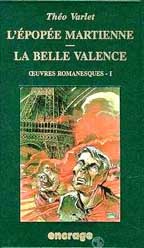 1921
1921
Théo Varlet & Octave Jonquel - "Les Titans du Ciel" [The
Titans of the Sky] (1921) and
"L'Agonie de la Terre"
[The Agony of Earth]
(1922) (Malfère).
A sequel to Wells' War of the Worlds.
The Jovians intervene to help Earth after another Martian attack on Earth, this time using rockets filled with
deadly gases. Earth is almost completely destroyed. The Soviets take over. Meanwhile, the Jovians punish Mars by
using focused solar energy to destroy it. However, the Martian Overlords (who look like Le
Rouge's Erloors from "Le Prisonnier
de la Planète Mars") escape to Earth. Our planet is then revealed
as the place where Martian souls reincarnate. Souls are alleged to travel inward from Mars, to the Earth, to Venus,
to Mercury, to end up being one with the Sun. This explains the original invasion.
In Volume Two, the destruction of Mars has released millions of Martian souls ready to take over human bodies.
The heroes fight the body-snatching Martians, this time with the help of the Venusians.
E. M. Laumann - "Le Mystère de Mars" in Lecture
pour Tous, March.
Prof. Legris receives signals from Mars
but his jealous assistant kills him before the signals can be decyphered.
Anonymous - Fascinax
No. 13. "Un Message de la Planète
Mars" (Message from Planet Mars).
Super-hero Fascinax
defeats bat-men-like Martians who have travelled to Earth in a rocketship and plan to invade -- however, this may
be an elaborate fake scheme by human villains.
 1924
1924
Henri Allorge - "Ciel contre Terre" [Heaven
vs. Earth] (Hachette).
Earth is again attacked by vampire-like Martians who again look like Le Rouge's Erloors from "Le Prisonnier de la Planète
Mars". These Martians, however, are defeated by alcohol.
André Müller - "La Planète Antennée" [The Aerial World] in Paris-Soir.
Theological story: the consequences on human religions of a message from Mars.
1925
J.-H. Rosny
Aîne - "Les
Navigateurs de l'Infini" [The Navigators of Infinity] (Oeuvres Libres) and its sequel
"Les Astronautes" [The
Astronauts] (written at the same time, but published only in 1960) (Hachette)
- For More about Rosny and This Novel.
The word "astronautique" is coined for the first time.
 The heroes travel to Mars in the "Stellarium", a spaceship powered
by artificial gravity and made of "argine", an indestructible, transparent material. On Mars, the explorers
come in contact with the gentle, peaceful, six-eyed, three-legged "Tripèdes", a dying race slowly
being replaced by the "Zoomorphs", alien mineral or metallic entities.
The heroes travel to Mars in the "Stellarium", a spaceship powered
by artificial gravity and made of "argine", an indestructible, transparent material. On Mars, the explorers
come in contact with the gentle, peaceful, six-eyed, three-legged "Tripèdes", a dying race slowly
being replaced by the "Zoomorphs", alien mineral or metallic entities.
In the sequel, a young Martian female, capable of bearing children parthenogetically by merely wishing it, gives
birth to a child after falling in love with one of the human explorers. This heralds the rebirth of the Martian
race and, with Man's help, the eventual reconquest of their planet.
Henri de Graffigny - "Voyage de Cinq Américains dans les Planètes"
[Voyage of Five Americans on the Planets]
(Geldage).
More exploration of the Solar System. The explorers leave Earth in a ship launched via a giant slingshot (same
technology as used in André Mas'
"Les Allemands sur Vénus"
(1914). The chapter "Autour du Système Marsien" [In The Marsian
System] enables the travellers to observe Mars, but a technical incident prevents
then from landing.
Anonymous - "Chez
les Martiens" [With the Martians] in Le Petit Robinson
No. 42 (21 April).
Travel to Mars; exotic creatures, wild flora, etc.
Marcel Jeanjean - "Les Fantastiques Aventures de Cadet et Cadette dans la Planète Mars" [The Fantastic Adventures of Cadet & Cadette
on Planet Mars] (1925-1926)
Series of vignettes recounting the adventures of Prof. Cornibus and his two youthful companions, Cadet and Cadette, on Mars.
The Martians use robots, who stage a revolt.
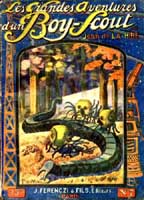 1926
1926
Jean de La Hire - "Les Grandes Aventures
d'un Boy Scout" [The Great Adventures of a Scout] (Ferenczi) (illustrations
by Geeorges Vallée).
30-episode magazine serial -- see complete list on the Nyctalope page.
The hero, Franc-Hardi, accompanied by
eleven boy scouts and five girls, explores the solar system in Engineer Korridès (who appeared in the Nyctalope
saga) radioplane. On Mars, they meet men from Earth who came to the Red Planet in the 18th centuruy. Then they
meet the native Kephales. They encounter exciting local; fauna and flora. A giant electronic tornado eventually
transport them to Saturn.
1928
Arnould Galopin - "Les Aventures de Monsieur Paturel" [The Adventures of Mr. Paturel] (Albin Michel).
107-episode magazine serial.
Paturel and Prof.
Van Der Thorn make a stop-over on Mars.
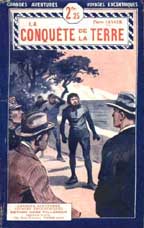 1931
1931
Pierre Lavaur - "La Conquête
de la Terre" [The Conquest of Earth] (Tallandier).
The Jupiterians are at war with Mars and kidnap Astronimer Edgar Rogotha. Colonel Mac Brody
helps defeat an invasion.
François de Nion - "La Dépêche de Mars" [Message from Mars] in "Contes
Sportifs et Fantastiques" (Librairie Universelle).
A lighthouse keeper mistakes a strange message for a message from Mars. In reality, it is phonetic basque.
Emmanuel Desrosiers - "La Fin de la Terre" [The
End of Earth] (Montréal, Librairie d'Action Canadienne-Française
Limitée).
The survivors of a planetary cataclysm emigrate to Mars on a giant plane, using an air tunnel between the two worlds
(source: Jean-Louis Trudel).
Jacques Tristan-Michel - "A la Conquête du Sgillium" [To Conquer Sgillium] (1930-40?)
Mars was colonized by the French in 2085. In 2215, it becomes the launching pad for an expedition to Planet X to
look for the mineral Sgillium.
1932
Louis Arraou - "Un
Martien sur la Terre" [A Martian
on Earth] (Figuière).
The hero meets Cléophas, who claims
to be from Mars. Cleophas has come to Earth to bring a message of peace, and describes a utopian Martian society.
He then departs in a flash of light.
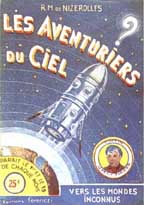 1935
1935
R.M. de Nizerolles - "Les Aventuriers
du Ciel: Voyages Extraordinaires d'un Petit Parisien dans la Stratosphére, la Lune et les Planètes" [The
Adventurers Of The Sky:ExtraordinaryVoyages Of A Little Parisian In The Stratosphere, The Moon And The Planets] (Ferenczi) (1935-37).
Sequel to Nizerolles' 1912 Les Voyages Aériens d'un Petit Parisien à
travers le Monde [The Aerial Voyages Of
A Little Parisian Across The World]
108-episode magazine serial.
The indomitable Tintin (no relation to
Hergé's character) uses the hydrogen-powered spaceship "Bolide" to explore the solar system. On
Venus, he finds descendents of the Greek Gods ruling a race of giant cyclops. On Mars, he comes across a race of
little men served by giant robots.
Jacques Loria - "La Visite des Martiens" [The
Visit of the Martians] (Figuière).
Prof. Dubreuil makes contact with Mars.
A Martian delegation comes to Earth and try to educate us, but in vain.
Paul Charles Severin - "Heureux Martien" [Happy
Martians] (Livres Nouveaux).
Paul de Kervan travels to Mars on the
"Épervier" (a propeller plane!). He finds a society ruled by an avaricious Queen. Soon a revolution
begins. Kervan marries a beautiful Martian girl.
1936
Maurice Limat - "Les Fiancés de la Planéte Mars" [The Fiancés of Mars] (Férenczi).
Interplanetary romance.
Maurice Limat - "Les Naufragés de la Voie Lactée" [Castaways of the Milky Way] (Ferenczi).
On the Antarctic, millionaire Gaston Lomond
and his friends defeat an invasion from invisible Martians who feed on electricity.
1937
Cami - "Chez
les Martiens ou Gare là-Dessous" [With
the Martians] in "Quand j'étais
jeune fille" (Baudiniére).
Sartirical story. Martians take advantage of Men's good intentions to invade Earth.
1942
Henri Dimpre - "Les
Evadés du Ciel" [Escape in
the Sky] (Ventilard).
Engineer Nic travels to Mars on the "Olive
Rouge". Bellicose Martians scheme to steal all of Earth's metals.
1943
Jacques Spitz - "Les Signaux du Soleil" [Signals
from the Sun] (Vigneau).
The Martians steal Earth's atmosphere's nitrogen, and the Venusians its oxygen, without suspecting Man's presence.
A scientist manages to make them aware of our existence.
1944
André Dassart
- "Anticipations" in "Histoires d'Avions" (OEP).
Prof. Zéphir Olibrius has been
visiting Mars and studying Martians for 4 years. But it's all a dream!
Roland Forgues - "Sur la Planète Rouge" [On
the Red Planet] (Maréchal, Liège-Bruxelles)
Illustrated story in which an Earth expedition goes to Mars looking for radium, and fight insect-like Martians.
 1945
1945
Guy Séverac - "Les Conquérants
de l'Infini" [Conquerors of Infinity] (La Jeunesse).
Young scientist Henri Nissac and girl-friend
Georgina Smolen travel to Mars in a rocket.
Martians are technologically advanced, peaceful, tentacled, spherical beings, with great mental powers. Returning
to Earth, they crash in the desert and forget their journey.
1946
René Henry - "Face aux Martiens" [Face
to Face with the Martians] (Zimmermann).
Mars has no fauna or flora; Martians extract their nutrition from the ground.
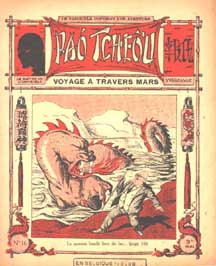
"Edward Brooker" - Pao Tchéou,
le Maître de l'Invisible No. 16 - "Voyage à travers Mars"
(Editions et Revues Françaises).
The world-spanning battle pitting Cropertot
and various heroes against the dreaded Oriental Mastermind Pao Tchéou, so-called "Master of the Invisible", spreads to Mars.
J. Vailland - "Les
Aventures de Pr. Plume" (Triboulet, Monaco)
(novelization of a radio serial).
Prof. Plume travels to Mars and meets
invisible, telepathic Martians. Mars is governed by women; a robot rebellion is crushed.
1951
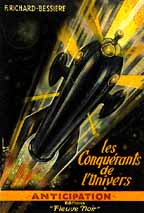 Henri Richard Bessière - "Les Conquérants de l'Universe" [Conquerors Of The Universe]
(Fleuve Noir Anticipation Nos. 1-4 & 37; 1951-54)
Henri Richard Bessière - "Les Conquérants de l'Universe" [Conquerors Of The Universe]
(Fleuve Noir Anticipation Nos. 1-4 & 37; 1951-54)
A band of Earthmen led by Prof. Bénac,
the inventor of a spaceship called the "Meteor", and comprised of a young French engineer, an American
journalist and a young British woman, explore the Solar System, helping friendly aliens and thwarting evil tyrants.
The novels were originally written in the mid-1940s.
Bessière late rewrote and updated the saga in a two-volume remake entitled Les
Pionniers du Cosmos [The Pioneers of the
Cosmos] (FNA Nos. 264, 268; 1965).
1952
Jimmy Guieu - "L'Invasion
de la Terre" [Invasion of Earth] (FNA No. 13).
Mars is dying so the Martians want to invade Earth. Earth's alliance with the Glamorians saves the day.
1953
Léopold Massiera - "L'Énigme des Soucoupes Volantes" [The Mystery of the Flying Saucers] (Ferenczi "Mon
Roman d'Aventure" No. 225).
Earth is attacked by mysterious aliens. Prof. Appelgreen
suspects Mars and dispatches astronaut Pierre Houdan
in a rocketship to investigate. The real enemies are revealed to be Selenites from the Dark Side of the Moon.
Maurice Limat - "Corsaires Invisibles" [Invisible
Corsairs] (Ferenczi MRA No. 230).
French air force ace Jean-Luc Mambert
defeats the crew of a Martian flying saucer who was attacking France.
Maurice Limat - "Courrier Interplanétaire" [Interplanetary Courrier] (Ferenczi MRA No. 266).
Futuristic story: Space courrier Antonia's
mission is to deliver a life-saving drug to a Martian colony, but the colonists' rivals on Deimos mean to stop
her.
Léopold Massiera - "La Course aux Etoiles" [Race
for the Stars] (Ferenczi MRA No. 270).
Futuristic story: on a United Earth, French, American and Japanese teams compete on a star regatta from Mars to
Venus and Mercury.
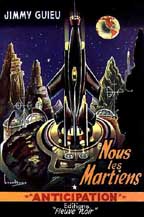 1954
1954
Jimmy Guieu - "Nous les Martiens" [We The Martians] (FNA No. 31).
Second novel (the first being FNA No. 27) featuring archeologist Jean Kariven. In the Kariven series,
Guieu explores his favorite themes such
as UFOs, ancient astronauts, esoteric secrets and occult societies. In Nous
les Martiens [We The Martians], Kariven discovers that, in the far distant past, men had emigrated to Earth from Mars.
Eight more Kariven novels follow: FNA
Nos. 36, 41, 45, 47, 51, 54, 58, 62 (1954-56), dealing with time travel, lost civilizations, plus a tetralogy featuring
a space war between the good alien Polarians and the evil alien Denebians, with Earth secretly caught in the middle.
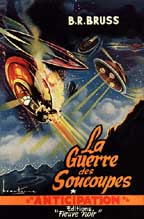 B.-R. Bruss
- "S.O.S. Soucoupes" & "La Guerre des Soucoupes" [War
of the Flying Saucers] (FNA Nos. 33, 40).
B.-R. Bruss
- "S.O.S. Soucoupes" & "La Guerre des Soucoupes" [War
of the Flying Saucers] (FNA Nos. 33, 40).
Earth vs. Martian flying saucers. A third volume (Rideau Magnétique [Magnetic Curtain],
FNA No. 65) follows the adventures of the offsprings of the heroes, further unto the future. The "Martians"
are revealed to be extra-galactic invaders, that have conquered the real (peaceful) Martians.
Maurice Limat - "A-117 a disparu" [A-117
Has Vanished] (Ferenczi MRA No. 289).
Futuristic story (23rd century): A Martian spy sabotages a space mission meant to stop an asteroid about to collide
with Earth.
Maurice Limat - "Les Forçats de l'Espace" [The Convicts of Space] (Ferenczi MRA No. 319).
Futuristic story: Mars is an Terran colony oppressed by Earth; Eric is a Martian rebel who escapes from slave labor
ship AB-33.
Lucien Prioly - "Alerte aux Martiens" [Martian
Alert] (Martel).
Worried about Earth's atomic tests, the Martians kidnap Marie-Jeanne Mayadoux and François Chamboux,
whose mission will be to convey an ultimatum to Earth. The abductees discover the Martian utopia, and visit Venus.
They return to Earth and succeed in their mission of peace.
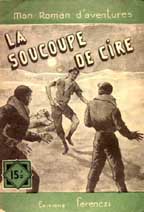 1955
1955
Henri Richard Bessière - "S.O.S. Terre" [SOS
Earth] (FNA No. 55).
The Martians fight the Oklontes, descendents from Atlantis.
Max-André Dazergues - "La Soucoupe de Cire" [The
Wax Saucer] (Ferenczi MRA No. 343).
In Africa, airforce pilot Gaston Merville
discovers a wrecked flying saucer, and fights its monstrous little passengers; the ship eventually melts away.
Louis de Wohl - "Mars ne veut pas la guerre" [Mars
Does Not Want War] (Salvator-Mulhouse).
An idyllic Martian civilisation.
Pierre Versins - "En Avant, Mars!" [Go,
Mars!] (Metal No. 14).
Satirical take on a war of the worlds.
1958
Paul Bellat - "Dix
jours sur Mars" [Ten Days on Mars] (Nef de Paris).
Futuristic story. At Orly Spaceport, the rocket France 1 takes off for Mars. On board, Professor
Nemo who is going on a research trip. Martians are friendly aliens.
1959
Henri Richard Bessière - "On a Hurlé dans le Ciel" [Screams in the Sky] (FNA No. 148).
Futuristic story: Earth has been taken over by the Kerlosians. Earth rebels plot to destroy the Kerlosian base
on Mars.

1960
Gérard Klein (writing as Gilles
d'Argyre) - "Chirurgien d'une Planète"
[The Planet Surgeon] (FNA No. 165); revised
in 1987 as Le Rêve des Forêts [A Dream Of Forests].
The popular Argyre trilogy describes the
future history of Man's conquest of the Solar System. The series is comprised of Chirurgiens
d'une Planète, which describes the terraforming of Mars by the enterprising
scientist Georges Beyle. It is followed
by Les Voiliers du Soleil [The Solar Sailors] (1961), in which Beyle, now linked
to a giant computer, defeats an alien invader; and finally Le Long Voyage [The Long Journey]
(1964), in which Beyle returns to launch a plan to turn a terraformed Pluto into a starship.
Article © 2002 Jacques Garin. All rights reserved.
Visit Jacques Garin's Mars website.
Traduction & adaptation by J.-M. Lofficier.
Research assist & scans by: Marc Madouraud, Jacques Boutel.
Bibliography: Jacques Sadoul "Histoire de la SF moderne" (1984); Pierre Versins "Encyclopédie
de l'Utopie et de la SF" (1972); Jean-Marc & Randy Lofficier "French Science Fiction, Fantasy, Horror & Pulp Fiction"
(2000).